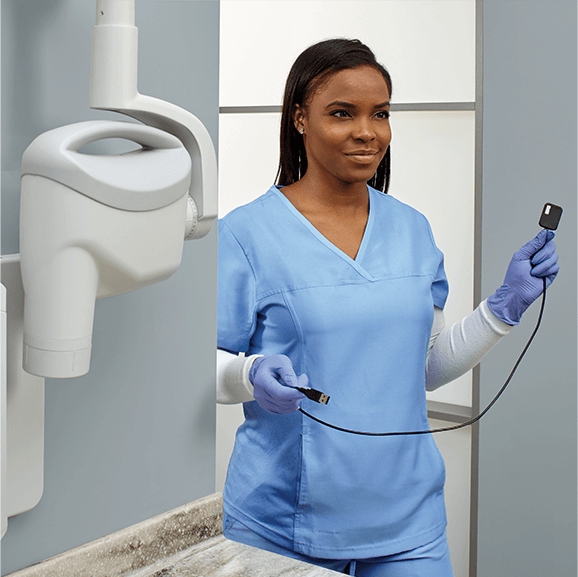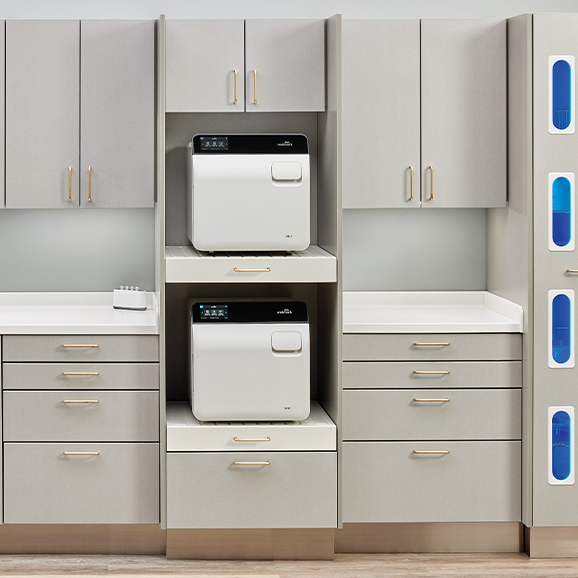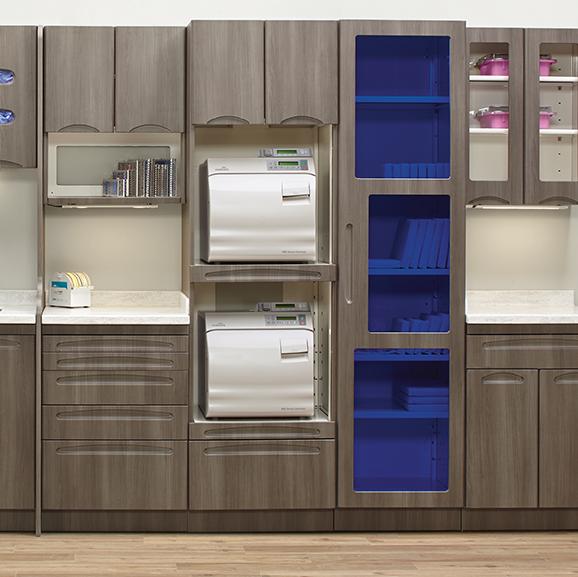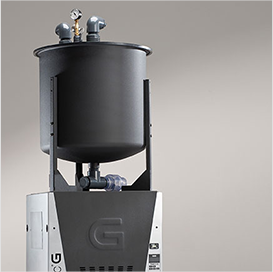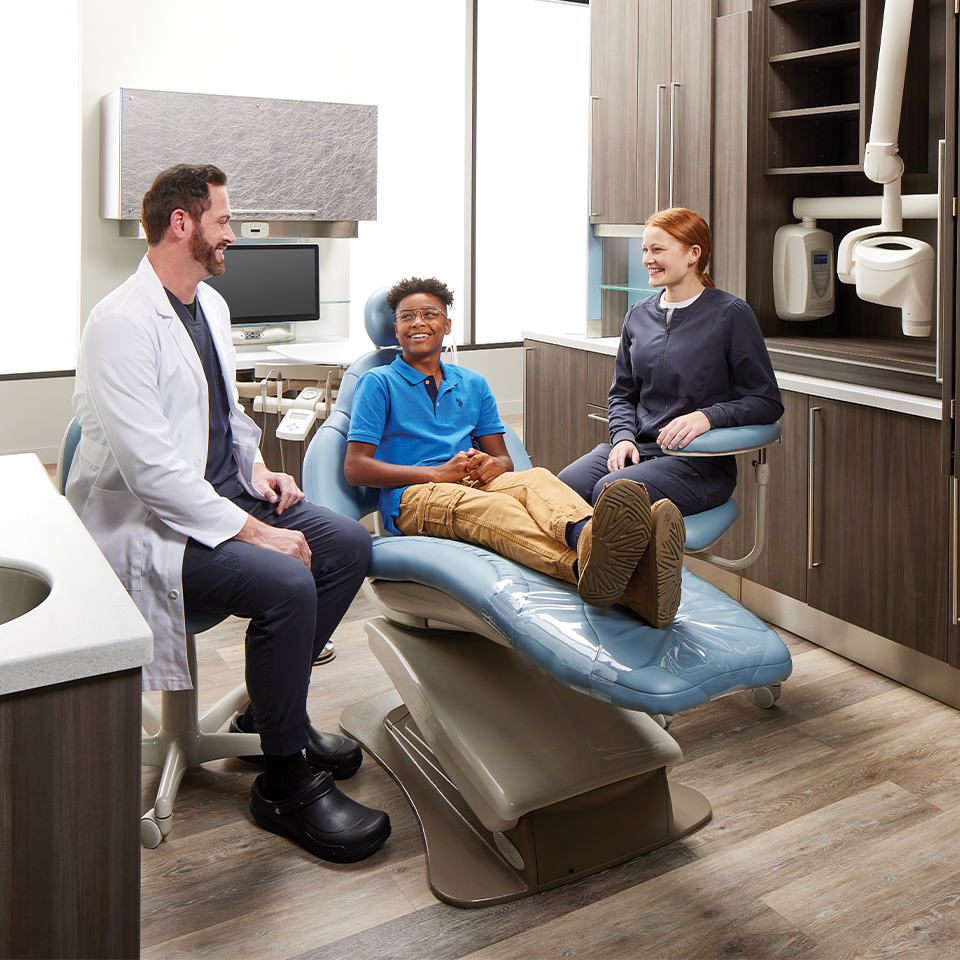June 5, 2025
In modern dentistry, instrument cleanliness stands as a cornerstone of exceptional care. This essential principal guides everything from daily procedures to long-term practice success. Enter the ultrasonic dental cleaner, a device that has revolutionized instrument hygiene. Precleaning instruments before sterilization is essential to ensure proper sterilization and safety for patient use.
With numerous options available in today's market, selecting the right ultrasonic dental cleaner can be challenging. It's a decision that many dental practitioners and practice owners face when upgrading equipment.
Whether starting fresh or upgrading existing equipment, this comprehensive guide will help you select the ideal ultrasonic dental cleaner for your practice.
Understanding Ultrasonic Dental Cleaners
Ultrasonic dental cleaners leverage advanced acoustic science to achieve superior instrument cleanliness. By converting electrical energy into high-frequency sound waves, these sophisticated devices generate microscopic cavitation bubbles that implode against instrument surfaces, effectively removing contaminants from even the most intricate dental tools. This non-negotiable first step in the instrument reprocessing workflow doesn't merely prepare instruments for sterilization—it fundamentally transforms practice safety protocols while establishing the scientific foundation upon which all subsequent infection control measures depend.
Why Cleaning Must Precede Sterilization
Proper instrument reprocessing follows a critical sequence where cleaning must occur before sterilization. This sequence isn't merely procedural—it's scientifically necessary:
- Bioburden (blood, tissue, saliva) creates protective barriers that prevent sterilizing agents from reaching microorganisms
- Organic materials can bake onto instruments during heat sterilization, creating permanent residue that compromises function
- Sterilization indicators may provide false results when obscured by debris, undermining verification protocols
The CDC, FDA, and instrument manufacturers all emphasize this sequence because sterilization simply cannot succeed without thorough cleaning first.
Manual vs. Ultrasonic: A Critical Comparison
Traditional manual cleaning presents significant limitations and risks:
Safety Concerns: Direct handling of contaminated instruments significantly increases sharps injury risks. According to OSHA data, these injuries remain among the most common occupational exposures in dental settings.
Cleaning Effectiveness: Human scrubbing cannot reach microscopic crevices, box locks, and serrations where dangerous pathogens remain protected. Studies demonstrate that manual cleaning misses up to 40% of instrument surfaces.
Instrument Degradation: Abrasive manual scrubbing accelerates wear on precision edges and delicate mechanisms, shortening instrument lifespan and compromising functionality.
- Compliance.
Since the inception of the Americans with Disabilities Act (ADA), accessibility has become a legal requirement. The ADA prohibits discrimination against individuals with disabilities in all areas of public life, including healthcare facilities and medical equipment. - Safety + Ergonomics.
A point of care designed with a focus on safety and ergonomic principles can have a positive impact on the well-being of healthcare workers, as well as productivity and efficiency levels. - Workflow Efficiency.
Designing for accessibility helps prevent potential overexertion or injury among staff who assist patients with limited mobility, allowing them to work more efficiently with less downtime. - Patient Experience.
For a patient population that is becoming older and dealing with more medical conditions, a visit to the doctor’s office can be very stressful and receiving adequate care can be challenging due to accessibility issues.
How Ultrasonic Technology Works
Ultrasonic dental cleaners operate on scientific principles that transform cleaning effectiveness:
- High-frequency sound waves (typically 25-40 kHz) create millions of microscopic cavitation bubbles in the cleaning solution
- These bubbles implode against instrument surfaces, creating localized pressure and temperature changes that dislodge contaminants
- The resulting mechanical action penetrates areas inaccessible to manual brushing, removing bioburden from the most complex instrument geometries
This technology doesn't merely supplement manual cleaning—it fundamentally transforms the cleaning process with precisely controlled energy that reaches every instrument surface, creating a level of cleanliness impossible to achieve through traditional methods.
When integrated into your sterilization workflow, ultrasonic technology establishes a scientific approach to instrument processing that enhances patient safety, protects your team, and preserves your instrument investment.
Benefits of Ultrasonic Cleaning in Dental Practices
Ultrasonic cleaning offers substantial benefits that extend beyond mere convenience. This sophisticated approach to instrument maintenance establishes new standards for professional practice excellence, infection control efficacy, and operational efficiency.
Clinician Safety
The implementation of ultrasonic cleaning systems provides meaningful protection for dental professionals through:
- Significant reduction in sharps-related injury potential through the minimization of direct contact with contaminated instruments, effectively reducing the risk of percutaneous injuries
- Mitigation of bioaerosol exposure hazards commonly associated with conventional manual instrument processing procedures
- Enhanced compliance with OSHA Bloodborne Pathogens regulatory requirements through systematic reduction of occupational exposure variables
Comprehensive Practice Advantages
The clinical benefits of ultrasonic technology extend considerably beyond safety considerations:
- Substantial operational efficiency improvements through the optimization of instrument processing timeframes
- Superior contamination elimination capabilities that address even the most complex instrument design features
- Extended functional lifespan of precision instruments through the elimination of mechanical stress associated with manual processing methods
Practice Excellence
The implementation of ultrasonic technology communicates fundamental practice values:
- Elevated infection prevention standards that exceed baseline industry requirementss
- Enhanced patient confidence metrics through demonstrable commitment to advanced safety methodologies
- Alignment with environmental sustainability objectives through optimized resource utilization
These interconnected benefits collectively establish ultrasonic cleaning technology as an essential component of contemporary dental practice infrastructure, representing not merely an equipment acquisition but a strategic investment in practice excellence.
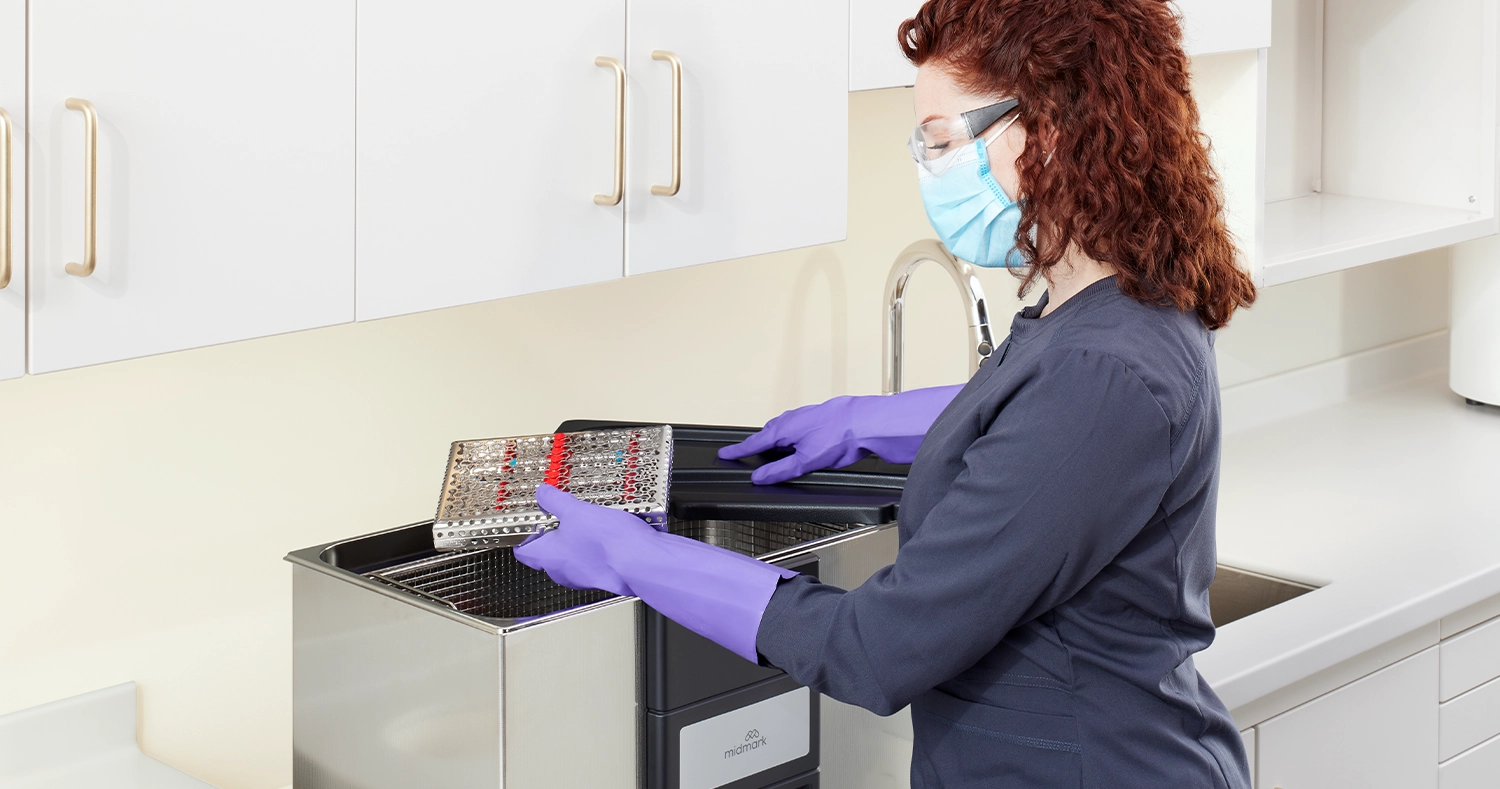
Key Features to Consider
Choosing the best ultrasonic dental cleaner requires understanding its key features. Features directly impact performance, efficiency, and durability.
Frequency + Tank Capacity
The frequency of an ultrasonic cleaner determines how effectively it removes debris. Typically, frequencies range from 25 to 45 kHz.
Higher frequencies result in finer cleaning suitable for intricate instruments. Additionally, tank capacity affects how many instruments can be cleaned in one cycle.
A larger tank may be needed in busy practices, enhancing workflow efficiency by accommodating more tools at once.
Functions: Timer + Degas
When evaluating ultrasonic dental cleaners, three key functional features significantly impact cleaning effectiveness and operational efficiency:
- An integrated timer ensures consistent cleaning cycles, preventing both inadequate cleaning from shortened cycles and unnecessary wear from extended processing. This precision timing optimizes performance while standardizing your sterilization protocols.
- The degassing function, though often overlooked, plays a vital role in ultrasonic cleaning effectiveness. This feature removes trapped air molecules from freshly prepared cleaning solutions before instrument processing begins. Degassing creates a more favorable environment for cavitation by eliminating microscopic air bubbles that would otherwise absorb ultrasonic energy and interfere with the cleaning process. During degassing, you'll observe small bubbles forming and rising to the solution surface as dissolved gases are released—a visual confirmation that your system is preparing for maximum cleaning efficiency.
By specifically selecting ultrasonic cleaners equipped with these two integrated features, you establish a comprehensive cleaning system that delivers superior results through precisely controlled timing and optimized cavitation power. This functional duo ensures your instruments receive consistently thorough cleaning, setting the foundation for sterilization success and extended instrument longevity.
Durability + Build Quality
When evaluating ultrasonic dental cleaners, specific construction details directly impact how long your unit will serve your practice. The best ultrasonic cleaners feature 316L medical-grade stainless steel tanks, which resist corrosion from harsh cleaning chemicals and won't pit or degrade over years of daily use. Standard 304-grade stainless steel or plastic tanks might cost less initially but typically show signs of deterioration within 1-2 years of regular use.
Control panels should be fully sealed with at least IPX6 waterproof rating – this prevents the most common cause of ultrasonic cleaner failure: liquid damage to internal electronics from splashes during solution changes.
Pay attention to these practical construction details:
- Welded seams rather than adhesive bonds (which can separate with repeated vibration)
- Rubber isolation mounts that prevent vibration transfer to countertops
- Drain valves made of brass or stainless steel, not plastic that cracks over time
The financial benefit becomes clear: premium ultrasonic cleaners typically remain in service for 7-10 years, while budget models often need replacement after just 2-3 years. When you factor in the disruption cost of equipment failure – potentially forcing appointment cancellations and workflow disruptions – the higher initial investment in quality construction provides significant long-term savings and peace of mind.
Selecting the Right Ultrasonic Cleaner for Your Practice
Selecting the optimal ultrasonic dental cleaner is a significant decision that resonates throughout your practice's operations. This choice merits thoughtful consideration as it directly influences sterilization protocols, workflow efficiency, and ultimately, standard of care.
First, it’s important to align any new technology with your practice’s unique circumstances. Start by conducting a focused assessment of your practice's operational profile:
- Patient volume patterns – Evaluate your typical instrument processing demands based on appointment scheduling
- Instrument inventory composition – Consider specialized tools requiring particular processing protocols
- Sterilization workflow architecture – Analyze how new technology will enhance established procedures
Practices managing higher patient volumes may benefit from more robust machines that handle higher workloads efficiently. Alternatively, a smaller or newly established clinic might prioritize cost-effectiveness and flexibility.
In addition, the size and type of your selection will determine how effectively it integrates with your existing space and procedural workflows. Various ultrasonic systems offer distinct advantages for specific clinical requirements, necessitating a comprehensive evaluation for compatibility.
Tabletop vs. Recessed Ultrasonic Cleaners
Tabletop Ultrasonic Systems transform available counter space into comprehensive cleaning stations. Their larger tank capacity accommodates extensive instrument processing requirements, providing particular advantages for practices that:
- May prefer more capacity options to meet workflow needs
- Implement instrument cassette protocols for enhanced efficiency
- Require a simpler installation process
Recessed Ultrasonic Solutions offer elegant integration within your sterilization center, providing distinct benefits for practices that:
- Prioritize a clean, streamlined workspace to maximize efficiency
- Implement instrument cassette protocols for enhanced efficiency
- Seek to maximize operational efficiency within compact clinical settings
Fostering Implementation Success Through Collaborative Approach
The most effective technology integrations involve meaningful engagement with clinical team members who interact directly with sterilization protocols:
- Gather insights regarding current workflow efficiency opportunities
- Identify specific features that would enhance daily operational effectiveness
- Evaluate how different ultrasonic configurations would integrate with existing protocols
This collaborative methodology ensures your selected technology achieves seamless integration that enhances sterilization protocols while maintaining workflow continuity.
Through thoughtful consideration of these essential elements, your ultrasonic cleaner selection transforms from a routine equipment acquisition into a strategic investment in practice excellence—one that delivers measurable benefits in efficiency, compliance and clinical outcomes.
Cleaning Solutions + Instrument Care
The effectiveness of an ultrasonic dental cleaning machine hinges on selecting appropriate cleaning solutions. These solutions not only lift debris but also protect the instruments from corrosion.
Instrument care extends beyond cleaning. Proper placement within the ultrasonic cleaner ensures all surfaces receive adequate exposure to cavitation. Routine maintenance of both the instruments and the machine is critical to prolonging their operational lives.
Choosing Compatible Cleaning Solutions
Choosing the right cleaning solution is imperative for ultrasonic cleaners to perform optimally. Solutions are formulated to work with specific materials and contaminants.
For dental instruments, select solutions that enhance cleaning without damaging delicate components. Read instrument manufacturer guidelines to confirm compatibility and to prevent adverse chemical reactions.
Your selected solution should align with both the machine's capabilities and the instruments' needs, ensuring efficient and safe operation.
Proper Instrument Placement + Maintenance
Correct instrument arrangement within your ultrasonic cleaner directly impacts cleaning efficacy and infection control outcomes. According to CDC Guidelines for Disinfection and Sterilization in Healthcare Facilities, "the efficacy of the cleaning process depends on thorough contact with the cleaning solution." This contact becomes compromised when ultrasonic units are improperly loaded.
Evidence-Based Loading Protocols
The Association for the Advancement of Medical Instrumentation (AAMI) ST79 guidelines provide specific recommendations for ultrasonic instrument placement:
- Maintain a minimum 1-inch clearance between instruments and tank walls
- Position instruments in a single layer without stacking or nesting
- Place hinged instruments in an open position to expose all surfaces
- Keep delicate items separated from heavier instruments that might cause damage
- Limit load capacity to 75% of basket capacity, even when using instrument cassettes
When instruments overlap or touch, "shadowing" occurs—areas where ultrasonic waves cannot effectively reach. This creates protection zones for bioburden, leading to incomplete cleaning and potential sterilization failure.
Solution Management Best Practices
The American Dental Association emphasizes the importance of proper solution management:
- Replace cleaning solution at least daily, regardless of perceived cleanliness minimum 1-inch clearance between instruments and tank walls
- Change solution immediately when visibly soiled or after processing highly contaminated instruments
- Maintain solution levels at manufacturer-recommended depths (typically 1 inch below the tank rim or fill line if the device has a fill line)
- Use only detergents specifically formulated for ultrasonic dental applications
- Regularly test ultrasonic activity using aluminum foil or commercial cavitation test strips
Preventative Maintenance Schedule
AAMI ST79 recommends implementing a documented maintenance program including:
- Daily: Drain, rinse, and dry tank at day's end to prevent mineral buildup
- Weekly: Clean tank with manufacturer-recommended descaling agent
- Monthly: Inspect transducers, control panels, and lid mechanisms for signs of wear
- Quarterly: Validate ultrasonic performance with quantitative testing protocols
- Annually: Schedule professional preventative maintenance service
When consistently following these evidence-based protocols, your ultrasonic cleaner will deliver optimal cleaning performance throughout its service life while supporting your practice's compliance with infection control standards. This systematic approach transforms your ultrasonic cleaner from a simple piece of equipment into an integral component of your comprehensive infection control strategy.
Safety + Environmental Considerations
Operating ultrasonic dental cleaners requires thoughtful attention to both safety protocols and environmental responsibility. These technologies offer significant advantages when managed properly but require specific procedures to maximize protection for your team, patients, and the environment.
Personal Protective Equipment + Safety Protocols
The CDC's Guidelines for Infection Control in Dental Healthcare Settings emphasizes that instrument processing requires comprehensive protective measures. When operating ultrasonic cleaners, staff should consistently use:
- Puncture and chemical-resistant utility gloves that extend to cover wrists
- Face shields or protective eyewear with side shields to prevent splash exposure
- Fluid-resistant gowns or lab coats to protect against contaminated aerosols
- Masks rated ASTM Level 3 when aerosol generation is possible
OSHA's Bloodborne Pathogens Standard (29 CFR 1910.1030) mandates proper PPE use when handling contaminated instruments or processing solutions. Beyond equipment, implement these critical safety protocols:
- Perform daily function tests before first use to verify ultrasonic activity
- Secure lids during operation to prevent aerosol release
- Position units away from water sources and sinks
- Train all staff on emergency procedures for chemical exposure or electrical issues
Environmental Benefits + Solution Disposal
Modern ultrasonic cleaners represent a more environmentally responsible approach to instrument processing. These systems:
- Reduce water consumption compared to manual scrubbing procedures
- Lower detergent usage through more efficient application
- Minimize reliance on disposable cleaning tools like brushes and sponges
- Use enzymatic cleaners that are often more biodegradable than traditional chemicals
However, solution disposal requires specific attention. The EPA classifies used instrument cleaning solutions as potentially hazardous waste due to biological contamination. Follow these responsible disposal practices:
- Never pour used solutions directly into storm drains or septic systems
- Consult local wastewater regulations for specific disposal requirements
- Consider neutralization systems that render solutions safe for standard disposal
- Document your disposal procedures to demonstrate regulatory compliance
The ANSI/AAMI ST79 guidance recommends establishing documented protocols for solution management, including testing, changing, and disposal schedules. By implementing comprehensive safety and environmental protocols, your practice demonstrates commitment to team member protection while minimizing environmental impact in alignment with sustainable healthcare practices.
Cost, Brand + After-Sales Support
Deciding on an ultrasonic dental cleaner requires thoughtful consideration of cost, brand reputation, and support services. Each factor can significantly affect your long-term satisfaction and device performance.
Investing in a reputable brand, like Midmark, often ensures quality and longevity. However, it is crucial to balance upfront costs with the potential long-term benefits, including durability and efficiency.
Evaluating Cost-Effectiveness + ROI
Determining the return on investment (ROI) involves assessing the efficiency and longevity of the cleaner. A cost-effective ultrasonic dental cleaner can reduce manual labor, reduce teammate safety risks from handling sharp instruments, and enhance cleaning accuracy.
By evaluating performance features and energy consumption, practices can make informed decisions that promise savings and improved workflow over time.
Importance of Warranty + Customer Service
The warranty offered by a manufacturer reflects confidence in their product. Warranty coverage provides peace of mind and protects against unexpected costs.
Equally vital is the level of customer support available, ensuring ongoing assistance and guidance, which is invaluable for resolving potential issues and maximizing equipment use.
Conclusion: Making an Informed Decision
Selecting the right ultrasonic dental cleaner represents far more than a simple equipment purchase—it's a strategic investment in your practice's infection control foundation. By thoughtfully evaluating key factors including size requirements, construction quality, functional features, and safety protocols, you position your practice for enhanced operational efficiency, superior instrument cleanliness and improved regulatory compliance.
The technology you choose today will influence countless patient experiences, staff safety outcomes and sterilization results in the years ahead. When implemented with proper training, maintenance protocols and quality solutions, your ultrasonic cleaner becomes not just another piece of equipment but a cornerstone of your practice's commitment to clinical excellence. As infection control standards continue to evolve, practices equipped with optimized ultrasonic technology will stand prepared to meet both current requirements and future challenges with confidence and professionalism.
Frequently Asked Questions: Ultrasonic Dental Cleaners
What is an ultrasonic dental cleaner?
An ultrasonic dental cleaner is a device that uses sound waves to thoroughly clean dental instruments by creating tiny bubbles that implode against surfaces, removing contaminants that manual scrubbing might miss.
How long does ultrasonic cleaning take?
Most dental instruments require 5-15 minutes in an ultrasonic cleaner for effective cleaning. Your instrument manufacturer may recommend specific times based on the types of instruments you're cleaning.
How often should I change the cleaning solution?
The cleaning solution should be changed at least once daily, and immediately if it becomes visibly soiled or after cleaning heavily contaminated instruments.
Do I still need to sterilize instruments after ultrasonic cleaning?
Yes, ultrasonic cleaning removes debris but doesn't sterilize instruments. After cleaning, instruments must still go through your standard sterilization process.
Can all dental instruments go in an ultrasonic cleaner?
Most dental instruments can be safely cleaned in an ultrasonic, but some handpieces and any items with plastic components, adhesives or certain metals may not be compatible.
How do I know if my ultrasonic cleaner is working properly?
You can test your ultrasonic cleaner's effectiveness using an aluminum foil test or commercial cavitation test strips. If the foil shows uniform dimpling or the test strip changes color as indicated, your unit is functioning correctly.
What cleaning solution should I use?
Use cleaning solutions specifically formulated for dental ultrasonic cleaners. General-purpose cleaners or household detergents can damage instruments or reduce cleaning effectiveness.
Is an ultrasonic cleaner better than manual scrubbing?
Yes, ultrasonic cleaners are more effective at removing contaminants from complex instrument surfaces, reduce the risk of sharps injuries to staff, and help extend instrument life by eliminating abrasive manual scrubbing.
The innovative Midmark QuickClean® Ultrasonic Cleaners combine advanced frequency-leap technology with user-friendly design to create an efficient, reliable solution for dental instrument processing needs. Available in both countertop and recessed configurations with 3.3-gallon (QC3/QC3R) or 6.6-gallon (QC6/QC6R) capacities, these versatile units deliver thorough cleaning regardless of instrument placement in the bath. By investing in these advanced ultrasonic cleaners, dental practices can enhance their infection control protocols, minimize staff exposure to contaminated instruments and sharps, and accelerate instrument processing times—all while maintaining the highest standards of patient care through consistently clean instruments. The intuitive LCD control panel, customizable settings and built-in safety features ensure your team can operate the system with minimal training, creating a less stressful sterilization workflow.

 Dental Practice SafetyOur imaging and sterilization workflow solutions help you create a safe environment for all, while maximizing efficiencies and satisfaction for patients and staff.
Dental Practice SafetyOur imaging and sterilization workflow solutions help you create a safe environment for all, while maximizing efficiencies and satisfaction for patients and staff.
 Ergonomic DentistryOur equipment is designed to promote proper posture for doctors, assistants and patients alike, while helping to provide the workflow that best suits your practice needs.
Ergonomic DentistryOur equipment is designed to promote proper posture for doctors, assistants and patients alike, while helping to provide the workflow that best suits your practice needs.
 High-Performance DentistryImproving your practice performance requires a skillful combination of technology, workflow and expertise in the dental space that only Midmark can provide.
High-Performance DentistryImproving your practice performance requires a skillful combination of technology, workflow and expertise in the dental space that only Midmark can provide.
 Dental SchoolsWe shine in support for dental schools from our reliable professional solutions to our partnerships with colleges and the communities they serve.
Dental SchoolsWe shine in support for dental schools from our reliable professional solutions to our partnerships with colleges and the communities they serve.
 Dental Support Organizations (DSO)With a broad range of clinical solutions, short product lead times and reliable support, we provide a consistent experience that lets you better serve your patients.
Dental Support Organizations (DSO)With a broad range of clinical solutions, short product lead times and reliable support, we provide a consistent experience that lets you better serve your patients.
 Independent DentistsOur total equipment solutions and clinical design specialists are standing by to help, you can get back to focusing on the exceptional care you provide to your patients.
Independent DentistsOur total equipment solutions and clinical design specialists are standing by to help, you can get back to focusing on the exceptional care you provide to your patients.
 Architectural ResourcesVisit our planning and design library for the architectural resources you need.
Architectural ResourcesVisit our planning and design library for the architectural resources you need. ImpactDesignAttend this workshop to learn how to define, refine and achieve your practice goals through effective dental office design principles.
ImpactDesignAttend this workshop to learn how to define, refine and achieve your practice goals through effective dental office design principles. Multi-Site MasteryMulti-Site Mastery is an immersive learning experience designed for dental leaders ready to take their organization to the next level.
Multi-Site MasteryMulti-Site Mastery is an immersive learning experience designed for dental leaders ready to take their organization to the next level.
 The Midmark ExperienceStart Here to Make Your Dream Office a Reality
The Midmark ExperienceStart Here to Make Your Dream Office a Reality

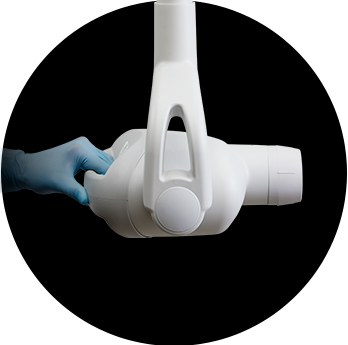 Midmark Preva Intraoral X-Ray PromotionThe order period has ended, but you can still claim your incentives through March 31, 2026. Redeem here.
Midmark Preva Intraoral X-Ray PromotionThe order period has ended, but you can still claim your incentives through March 31, 2026. Redeem here.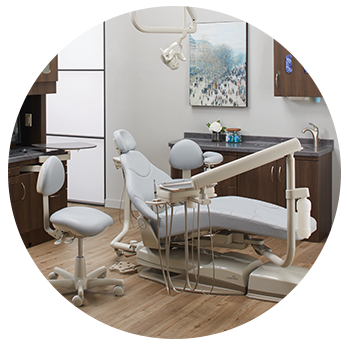 Midmark Choice PackagePair a Midmark Ultra-series dental chair and Asepsis 21® doctor's delivery system to receive 20% off your chair, delivery system and additional eligible options.
Midmark Choice PackagePair a Midmark Ultra-series dental chair and Asepsis 21® doctor's delivery system to receive 20% off your chair, delivery system and additional eligible options.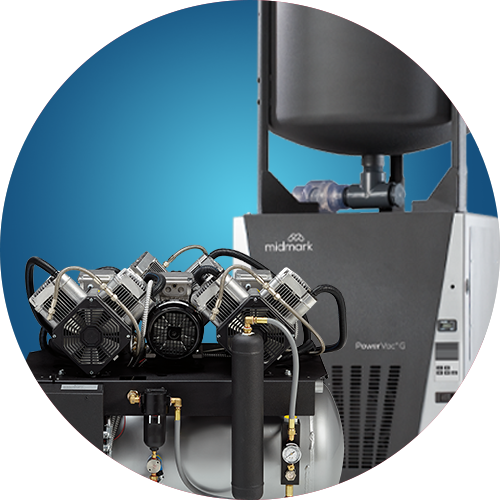 Mechanical Room PromotionUpgrade to Midmark air compressor and vacuum equipment now to claim free accessories and special savings.
Mechanical Room PromotionUpgrade to Midmark air compressor and vacuum equipment now to claim free accessories and special savings. Product LiteratureDesigning the best healthcare experience isn’t always easy. We can help.
Product LiteratureDesigning the best healthcare experience isn’t always easy. We can help.
 Product SpecificationsReview features and technical specifications for the products you want to learn more about.
Product SpecificationsReview features and technical specifications for the products you want to learn more about. InfographicsSee the whole picture with visual explanations and real-world applications.
InfographicsSee the whole picture with visual explanations and real-world applications. Webinars + PodcastsView and listen to the latest from Midmark here
Webinars + PodcastsView and listen to the latest from Midmark here EbooksLearn what we’ve uncovered about designing better care.
EbooksLearn what we’ve uncovered about designing better care. ImpactDesignAttend this workshop to learn how to define, refine and achieve your practice goals through effective dental office design principles.
ImpactDesignAttend this workshop to learn how to define, refine and achieve your practice goals through effective dental office design principles. Multi-Site MasteryMulti-Site Mastery is an immersive learning experience designed for dental leaders ready to take their organization to the next level.
Multi-Site MasteryMulti-Site Mastery is an immersive learning experience designed for dental leaders ready to take their organization to the next level.
 Service + Support | DentalAsk our Customer Experience team for help with product information, promotion details or contacting a sales representative.
Service + Support | DentalAsk our Customer Experience team for help with product information, promotion details or contacting a sales representative.
 Product Manuals (Technical Library)Discover everything you need to know about our products in one location.
Product Manuals (Technical Library)Discover everything you need to know about our products in one location.
 Technical Support | DentalFind parts, documentation and more with the help of our dedicated Technical Service representatives.
Technical Support | DentalFind parts, documentation and more with the help of our dedicated Technical Service representatives. Delivery + Installation ServicesMidmark Delivery Services will professionally manage your Midmark equipment shipping, delivery, staging and installation for maximum project success.
Delivery + Installation ServicesMidmark Delivery Services will professionally manage your Midmark equipment shipping, delivery, staging and installation for maximum project success.


